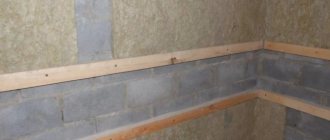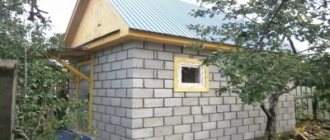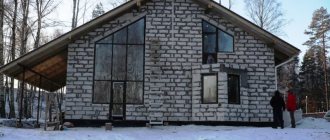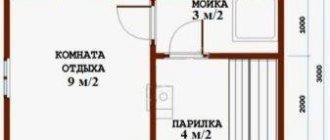In the ranking of inexpensive ways to arrange steam rooms with your own hands, a bathhouse made of expanded clay concrete blocks rightly occupies one of the first places. The reason for such high popularity is the availability of technology for manufacturing materials for masonry walls. Only by making expanded clay concrete with your own hands can you save more than one thousand on a bathhouse made of expanded clay blocks, while remaining completely confident in the quality and reliability of the material.
What is expanded clay concrete?
Expanded clay concrete is a type of building material. It is monolithic and hardens naturally. It consists of expanded clay, cement, sand, as well as special air-entraining additives. It differs from traditional concrete by its lightweight filler – expanded clay.
Expanded clay concrete block Source beton-house.com
Step-by-step instruction
You can easily build a bathhouse from expanded clay concrete blocks with your own hands, without resorting to the help of specialists, but you need to follow all the technologies correctly. The construction of such structures is phased and begins with preparing the project and clearing the area of grass, stones, trees and debris. If there are small elevations and holes on the site, they are leveled and filled. When everything is ready, they begin to carry out the main work and complete everything with external and internal finishing.
Preparation
Before you begin the actual construction of a bathhouse from expanded clay concrete blocks, you will need to calculate the material; for this you need to decide in advance on the options for decorative finishing inside and outside the building. In addition, it is necessary to additionally purchase material for laying communications. As soon as the blocks are delivered to the site, they are unloaded on pallets at a distance of 10 m from the future foundation.
Foundation
Structures made of expanded clay concrete blocks are usually erected on a foundation strip, for the preparation of which you can use rejected blocks with slight deviations in geometry. This material is characterized by high thermal insulation, but requires additional waterproofing of the base.
To do this, it is recommended to cover the blocks with polypropylene film and mastic. If you plan to build a bathhouse less than 9 m2 in size, then the blocks do not need to be filled with concrete mortar (it is enough to just fill the cracks and joints with a dry mixture of sand and cement). For the construction of large buildings, the tape must be filled with concrete.
When constructing bathhouses in regions with harsh climatic conditions, the site must be insulated before laying the blocks. The laid tape is rolled up from the outside with roofing material, then the material is folded and the edges are fixed to the base. The first row of the strip foundation is laid out on a cement mortar, to which a plasticizer must be added. The thickness of the solution should not exceed 3 mm.
Wall masonry
The construction of the walls of the future bathhouse should begin with pulling the rope and installing beacons. After this, you can lay the first row using cement mortar, the thickness of which should be no more than 3-4 mm. The remaining solution is removed with a trowel. The second and third rows are laid out in the same way as the first, then you need to put a metal mesh on the solution and continue laying out the remaining rows
It is important to take into account that the mesh must be laid every three rows. We must also not forget about installing “pockets” for installing floor and ceiling beams; the very last row is laid out in solid blocks
Pros and cons of expanded clay concrete baths
For a properly constructed bathhouse made of expanded clay concrete blocks, the pros and cons are dictated by the characteristics of the material. When choosing expanded clay concrete for the construction of a bathhouse, it is necessary to take into account all the features so that in the future the extension will serve for a long time, and its owner will not regret the previously made choice.
The main advantages of objects made from this building material include:
- Installation work is completed in a short time because there is no need for a technological break in the process of working on the structure: for example, when using foam or aerated concrete, you need to wait three to six months.
- Sufficiently large parameters of the blocks ensure ease of working with them. In addition, despite such dimensions, the material is easy to install, so there is no need to use special equipment.
- The construction of a bathhouse from expanded clay concrete blocks occurs without the use of special masonry mortars, because an ordinary concrete mixture or adhesive foam is prepared for fastening the building materials.
- Quite low cost of expanded clay concrete blocks.
- The walls of the structure are very smooth. In addition, their surface is easily amenable not only to plastering, but also to other methods of wall cladding.
- Long service life of the bath.
- No additional vapor barrier of the walls is required, which also helps to save on the construction of a bathhouse.
- Quite low moisture absorption coefficient.
Expanded clay concrete blocks are smooth and easy to lay Source stroim-dv.com
However, in addition to the advantages, there are also several disadvantages that should not be neglected:
- This material should not be chosen if the project involves the construction of a two-story bathhouse with an attic.
- Expanded clay concrete blocks are characterized by increased fragility, which is why they can collapse even from a slight impact or mechanical damage.
- Also, many experts call a significant drawback the need for mandatory cladding of both external and internal walls, and the use of cladding materials, accordingly, increases the cost of money for construction work.
- You need to build a strong and stable foundation.
Building from blocks has both pros and cons, but the number of advantages outweighs the number of disadvantages. In addition, thanks to the right architectural solutions, even the slightest defects can be easily eliminated. For this reason, you can safely order a bathhouse project made from expanded clay blocks, and it is better to turn to professionals for such a service.
Exterior cladding
No matter how warm and strong a sauna made of expanded clay blocks may be, it itself does not look very attractive. An excellent solution to this problem would be the use of decorative plaster, which enhances the aesthetic qualities of concrete blocks. They begin to look no worse than a simple brick, and at the same time do not lose their positive qualities. In addition, the external finish is quite effective protection against precipitation and frost.
If batts are placed under siding, care must be taken to ensure that the wind does not blow through them. The necessary protection is provided by special insulating membranes. Please note: when purchasing, you should make sure that they are capable of passing steam. It is advisable to paint the plaster layer with facade paints, which enhance resistance to moisture. And before plastering itself, experts recommend using concrete contact to ensure maximum adhesion.
The choice of finishing with siding or attaching plastic panels helps reduce the labor intensity of work. Such decoration methods are accessible even to non-professionals. And the rarest option is to apply paint and varnish material without prior plastering.
How to choose the right blocks?
To begin construction of the facility, you need to purchase expanded clay concrete blocks. After all, the performance properties of the finished structure directly depend on the quality of materials.
It is better to purchase blocks from a trusted supplier Source ufasnab.ru
See also: Contacts of construction companies that offer the service of building a bathhouse from expanded clay concrete blocks.
First of all, you need to find a trusted supplier who guarantees high quality products - this will allow you to purchase good material with suitable performance characteristics. When choosing blocks, you should carefully check them for chips, microcracks, and deep scratches. In addition, you need to make sure that they are reliable and durable so that they do not crack even from the slightest blow. An important factor is the color of expanded clay concrete blocks, because, for example, dark gray colored products are made from a mixture with a high concentration of cement - they are stronger and more durable.
Structural destruction
Expanded clay concrete blocks are unsuitable for the construction of overly complex or multi-story buildings. Budget building materials are very often counterfeited.
When choosing, be sure to pay attention to the geometry of the blocks. Buildings built from materials of different sizes are subject to shrinkage and noticeable swelling
All corners and edges of high-quality blocks should be as smooth as possible, and their surface should be rough, without chips or cracks. Numerous white and black inclusions, as well as a noticeable yellowness of the building material, are evidence of excess sand or irregularities in the production process.
In order to enjoy all the benefits of a bathhouse made of expanded clay concrete for many years and prevent the occurrence of operational problems, it is very important to strictly follow the work technology at all stages of construction, as well as to carefully consider the choice of finishing materials
Construction technology
Compliance with construction technology is the key to the longevity of the bathhouse Source openoblokah.ru
In order for a bathhouse built from expanded clay concrete blocks to serve for a long time, you must strictly follow the rules of the technological process:
- Special beacons are installed at the corners of the intended area;
- a strong rope is stretched between them, around the perimeter of which the blocks are laid (before this, it is necessary to clear the entire area of various debris to prevent deformation of the structure being constructed);
- It is best to remove the remaining mortar used to attach the blocks immediately before it dries;
- reinforcing mesh should be laid every two rows;
- to erect a single-pitched or gable roof, the support beams are fastened with anchor bolts, and then the roofing material is laid;
- In order for the bathhouse to be used during the cold season, it must be insulated with mineral wool, which has water-repellent and heat-insulating properties. It is secured from inside the building;
- the outer surface of the walls is covered with waterproofing and protective material;
- Wood or tiles are used as finishing materials indoors, and wood is most often chosen for exterior finishing.
Features of bath design
Design of a bathhouse made of expanded clay concrete Source vashslesar.ru
Before starting construction work, as a rule, they draw up a project that takes into account all the features of the object and the wishes of the owner of the site:
- an accurate model of the planned structure is created;
- the area of the entire structure and the dimensions of each room are determined;
- convenient parameters are established, as well as the location of openings for doors and windows;
- the amount of building materials is determined.
Even if you plan to build a bathhouse from blocks with your own hands, it is better to order the project (photos are posted in the article).
Construction of the foundation of the object
Under a bathhouse made of expanded clay concrete blocks, it is necessary to build a foundation of crushed stone and sand. Its thickness is calculated taking into account the type of soil. The work is carried out in the following order:
- The area is completely cleared of debris.
- The top layer of soil containing plant roots is removed.
- The soil surface is leveled.
- The foundation is marked.
- A ditch is dug, the depth of which is 0.5 m.
- A sand cushion is poured, which must be compacted tightly with feet or special equipment. In this case, you need to constantly add liquid to make the surface hard and well stable.
- A layer of waterproofing is created.
Foundation for a bathhouse Source optopg.ru
After completing all the above steps, you can lay the blocks. The seam between them should not be thinner than 1.5 cm. In order to increase the strength of the foundation, reinforcing mesh is used - it prevents the building from warping.
Loss of frost resistance
The lightness and uniformity of expanded clay concrete in buildings is preserved for a long time only if it is properly cladding and uses special finishing materials. In this case, the thermal conductivity coefficients depend on the density and in the dry state vary within the range of 0.1–0.66 W/m °C.
In order to preserve the characteristics, it is recommended to use modern insulating materials in the form of environmentally friendly and safe thermal fiber and jute felt. Immediately before insulation, the internal surfaces are cleaned and plastered. Mineral wool and expanded polystyrene sheets, which are lightweight and low in cost, are also a good option due to their fire resistance, strength, and high resistance to fungi and mold.
Video description
They tell you more about insulating baths in this video:
Features of external decoration
In order for the finished structure to acquire an aesthetically attractive appearance, the external walls should be finished. For this, as a rule, various materials are used that have not only decorative, but also protective functions. Quite often, preference is given to clinker panels, special facing bricks, plaster, which is then coated with paint, and hanging facades. These materials are beautiful and affordable.
One of the inexpensive cladding options is cement plastering. For it you need to prepare a solution of cement and sand in a ratio of 1:4. The mixture is applied in one layer, and then grouted, so that the result is a smooth surface with a uniform shade. To make the walls look even more attractive, it is recommended that a day after the plaster has dried, cover them with another layer of mortar and rub it in. At the end everything is covered with paint.
Painting as an option for exterior finishing Source blog-potolok.ru
Finish options
To improve the appearance of a bathhouse built from blocks, it is necessary to carry out interior and exterior decoration. This will create the effect of home warmth and comfort in the premises. External cladding will give the building a stylish look, thanks to which it will fit perfectly into the landscape design of the site.
From the inside
After the bathhouse has been built and all external work has been completed, the most crucial moment remains - finishing the premises inside. The walls and ceiling can simply be covered with clapboard, having previously prepared the base (plastered with cement-sand or gypsum mortar). As for the floor covering, you can lay a “warm floor” and tiling the top.
Stages of work to create a foundation for a bathhouse
When the trenches are ready, construction of the foundation of the building can begin. All construction work is divided into several stages:
- Laying a sand-gravel or sand-crushed stone cushion.
- Creation of a waterproofing layer.
- Construction of the first base layer from FBS or expanded clay concrete blocks.
- Reinforcement of the foundation with corrugated rods of medium section.
- Filling trenches with concrete solution.
It is worth remembering that the blocks must be bonded together with a solution before the main pouring.
The optimal dimensions of the seams should not be more than 1 cm. Secondary moisture insulation must be laid after the foundation tape has completely dried. This way there is a greater chance of preserving the foundation from constant dampness.
Interior finishing
Even when construction and exterior decoration are completed, one more important problem remains - what exactly to sheathe and finish the walls with. The advantages of expanded clay concrete do not give reason to forget that craftsmen are limited in the choice of finishing materials. And even what can be applied in principle is not always justified. When plastering, it is recommended to use gypsum or cement-sand mortar; it will mechanically strengthen the rough surface.
Gypsum compounds are considered lighter and more comfortable and retain heat better. If you have purchased a mixture that can be used without pre-treatment with concrete contact, it is advisable to reinforce the plaster with mesh made of polymers or steel. Moreover, polymers are considered more practical and convenient to use. The finishing cladding will become more beautiful if you use ceramic tiles or natural stone. These materials usually do not require surface preparation at all, although a special tile adhesive may be used.
Furnace structure
You cannot ignore such a moment as choosing a stove bath. The main criterion for this choice is the achieved thermal power and the ability to adjust it. The size of the steam room helps determine whether sufficient heat is generated. On summer days it will warm up in an average of 30 minutes, and in winter about an hour.
Taking into account the heating of the oven, the stones in it and the water tank, the resulting figure can be safely increased by 2.5–3 times
When calculating, they also take into account what the walls and floor are covered with, how powerful the thermal insulation is provided, and how much heating of the bath is required. Adjusting power is easiest for gas and electric heaters; it is a little more difficult to do with wood heaters
The adjustment methods are as follows:
- air control;
- heat removal to the outside;
- adjusting the flow of fuel inside.
You cannot install a low-power device that would reduce costs. After all, even if such a furnace manages to work properly, it will have to produce all possible power and continuously work to the point of wear and tear. Therefore, the service life is noticeably reduced. A traditional-looking stone stove will only be acceptable if you have a professional stove maker in mind. Adherence to tradition will force you to put up with prolonged heating and difficulties during ignition.
The firebox can be either elongated for installation in a wall, or regular. The first type has lower fire risks and allows you to create a comfortable microclimate, but may be more expensive. To reproduce a real Russian stove, it is recommended to buy an autonomous electric steam generator; it can cope with all possible problems.
In the open format, the air is heated by the stones themselves, heated on the fire. This solution is ideal for a heavily visited bathhouse: the air in the steam room is thoroughly warmed up very quickly and cooled down in the same way. The closed oven is equipped with a special damper that helps isolate the top row of stones. But long-term retention of heat results in slower heating overall. Among other parameters, it is always worth finding out how long the stove can heat a room without receiving additional fuel.
Masonry
The construction of ceramic block walls is not difficult:
- prepare cement;
- install the bottom row, starting from the corner of the base;
- check horizontality;
- build subsequent rows of masonry, shifting the blocks by 20 cm;
- perform reinforcement at intervals of 3 rows with reinforcing bars;
- strengthen the openings with reinforcement;
- Fill the contour of the walls with an armored belt - the basis for the rafters.
All that remains is to install the rafters and roof, and then begin finishing.
Ceiling beams and rafter system
The weight of the attic floor and roof will be distributed evenly across all load-bearing structures by a reinforced concrete belt - one piece, one for the entire load-bearing perimeter. The cement-sand mortar is poured onto the last row of masonry, into the formwork, onto a pre-laid reinforcing belt (for example, 4 rows of reinforcement with a diameter of 10 mm, connected into a mesh with a jumper spacing of 30 cm).
Attention! It is good for wooden floor beams (to which the rough ceiling is attached from below, and the attic floor from above), rafters, and rafter legs to rest on a wooden frame. The role of the Mauerlat is often played by a wooden beam, securely fixed to a concrete belt and isolated from it with sheet or coating insulation. Please also note that all wooden elements of the structure, including the rafter system of the bathhouse, need protection from rotting and fire with special impregnations
Please also note that all wooden elements of the structure, including the truss system of the bathhouse, need to be protected from rotting and fire with special impregnations. The weight of a symbolic attic (without economic load on its floor) and the light roof of a small bathhouse will be supported by beams 150 × 50 mm with a step of 60–80 cm between them
Long beams can not be cut, but extended from one or both sides, and supported by outrigger posts (using a common crossbar)
The weight of a symbolic attic (without economic load on its floor) and the light roof of a small bathhouse will be supported by beams 150 × 50 mm with a step of 60–80 cm between them. Long beams can not be cut, but extended from one or both sides, and supported by outrigger posts (using a common crossbar).
A simple roof structure - boards and corrugated sheets. Wind protection between them is not necessary, but if it is installed, it should be under the counter-lattice (so that the metal roof does not rust).











